Back to Loch Ness Reflections
It
was recently announced that Scottish Natural
Heritage (SNH) was forming a Loch Ness Environment
Panel with a view to developing
a code of practice for visiting monster hunters
who might inadvertently cause damage to the
loch's habitats, or individual creatures within
it. This move was prompted by the proposal
of a Swedish monster hunter and ufologist
Jan Sundberg, to place a 6m long creel trap
in Loch Ness. The SNH area manager Jonathan
Stacey, made it clear that they had no policy
on Nessie as such and the prime aim was to
"protect the known from those pursuing the
unknown".
This is but the latest episode in a long interaction between those with
responsibility for the loch and some of the
unconventional activities which take place
there.
In
the sensational days of 1933 the M.P. for
Inverness-shire, Sir Murdoch Macdonald, persuaded
the Secretary of State for Scotland to have
the local constabulary issue warnings "for
the purpose of preventing any attempt on the
animal, if sighted". Given the offer by Bertram
Mills Circus of £20,000 for its live capture,
it must have seemed that the "Monster" was
in some danger. Nevertheless, the huge scaffolding
cage erected in preparation was to remain
empty.
 Scaffolding Cage 1933
Scaffolding Cage 1933
Photograph *SMG Newspapers Ltd
Reproduction without
permission is forbidden without
advance permission.
To obtain permission
please contact rights@smg.plc.uk

L.N.I.Large Eel Trap Early 1970's Copyright D. Raynor
The Great Trap
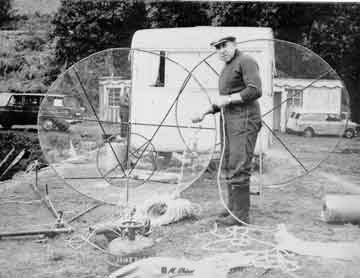
The
next attempt was rather less sensational and
came at the end of a decade of work by the Loch
Ness Phenomena Investigation Bureau (LNI).
Organised surface watches had failed to reveal
the monster of popular expectation yet a huge
volume of unexplained eyewitness testimony
remained. Effort had moved underwater and
thoughts were turning back to some of the
original local "huge eel" ideas. In 1970,
a study of the eel population was being made
anyway, as one of the first attempts to incorporate
some general biological research into the
LNI activities. In addition to the eel traps,
four "Great Traps" were made in case a small
specimen of the larger quarry could be persuaded
to enter. The traps were conical with the
apex anchored to the bottom and measured 6ft
high by 5ft across, with a spring loaded cover
triggered by tension on a bait pouch inside.

Bob Love's Proposed Trap
Nothing
was caught but this did not deter The LNI
Scientific Director, the American, Roy Mackal
or the leader of underwater activities, Bob
Love. They proposed a number of traps 18ft
by 6ft by 6ft built of plastic tube, which
could be purged with compressed air to bring
them to the surface if successful (Mackal, 1976 p 382). The
traps would be anchored to the loch bed with
a service platform moored at the surface.
A radio alarm would be given if the trap doors
were triggered. This temporary isolation of
a specimen (for tissue sampling and photography)
was seen as the final objective but the LNI
left the field in 1972 with no funding forthcoming.
There was however, a legacy.
At the end of the seventies, a monster was
indeed discovered in the loch, a monster with
no less than thirteen mouths! It was a flat
worm less than two centimetres long but very
undesirable because "Phagocata woodworthi"
was an invader. It had never been found outside
the American Continent before 1977 but here
it was, in the shallow water at Invermoriston (Reynoldson et al. 1981). By 1984
The Loch Ness Project had also discovered
it on the 200m deep basin floors (Shine & Martin, 1988, p 146 and Martin, Shine & Duncan, 1993 p 113 ). It was most probably introduced on equipment
brought in during monster hunts. In 1991, J. O. Young
showed just how undesirable this introduction
was, since he found that it out competed native
species for food (Young
1992). The Project also found another American
immigrant, the freshwater shrimp Crangonyx
pseudogracilis, but to be fair, it had been
spreading northwards from its first discovery
in London during the 1930's. However it was
the first time it had been recorded in a Scottish
loch so a question remains.
The Greatest
Trap
It was to be 1984, before Bob Love's idea was
tried by a Liverpool civil servant named Steve
Whittle who obtained support from the Vladivar
Vodka company.
His plans called for a huge trap to be winched
into the loch by a Chinook helicopter and
maintained for a month at a depth of 30ms.
His proposal to use live fish as bait raised
concerns with the Fishery Board. This was
because of the risks of introducing disease
and because escaping fish, brought from elsewhere,
might breed with the native stock, so affecting
the gene pool. This was the point at which
the Loch Ness Project became involved since
they were working with the board at the time,
on a number of fish studies.
Mr. Whittles scheme
was approved with the proviso that the Project
agreed to undertake design, construction and
deployment of the trap. This was perhaps the
first move towards the Environment Panel of
the year 2000.
Thus by a strange
irony, the Project, in return admittedly,
for what amounted to two years funding, found
itself with a not inconsiderable technical
challenge with an objective it found difficult
to take seriously.
Things
had moved on by then and even the most optimistic
expectations for the size of an unknown animal
would be nowhere near the specified 60ft.
length of the trap. But a lot had to be taken
seriously. To begin with, the Project might
be wrong and a great deal of the Project's
work has always revolved around this notion!
The trap would have to be built ashore and
be photographed, fly over Fort Augustus beneath
a small helicopter without breaking up and
be photographed, land on the water and be
photographed, and be immersed 30ms down for
a month. As if that weren't enough, it must
pose no threat to navigation or the loch's
known inhabitants and in the event of a successful
capture, should any harm come to the captive,
then it would be too late to say that the
eventuality had not been taken seriously.
In any case, there was the matter of professional pride!
Therefore, in a
field at Fort Augustus, a true monster emerged
in the shape of a great cylinder or "creel".
It measured 60ft long and 20ft in diameter
with doors at either end. It was made from
"pultruded" fibreglass tube, reinforced with
larger plastic tubes, designed to be very
slightly buoyant in the water and of course,
light in air. The triangular gaps between
the tubes were over a metre on the longest
side; quite sufficient to allow native fish
and otters to pass through. This was a year
before it was definitely established that
seals enter the loch. The tubes were secured
by ties and tape. In the event of a really
huge capture the degree of success could probably
be measured by the amount of damage to the
trap!
The Vladivar
Trap
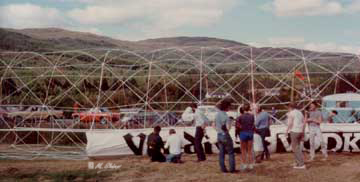
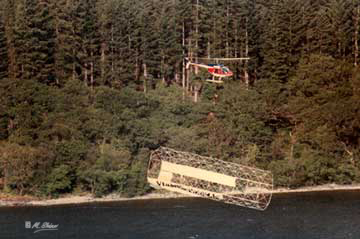
On
29th August 1984 a helicopter (much
smaller than the Chinook originally proposed)
took the strain on a "bridle" which distributed
the load along both sides of the trap and
flew it over fort Augustus, the sponsors banners
forming an aerodynamic tail to make it fly
straight. Four and a half kilometres along
the loch, it was flown in towards a raft moored
off one of the steepest parts of the shore.
Here the "Horseshoe Scree" plunges down 700ft
beneath the surface giving room to moor the
structure in open water. Of the four lines
securing the raft, only the inner two could
be attached to the shore while the outer ones
were over 2000ft (660m) long and held by anchors
out on the loch's flat bed beyond the slope.
As the helicopter released the bridle, the
trap inverted itself with floats, allowing
the same bridle to be attached to a line running
through an anchor weight about 300ft below.
Once steadying lines had been run from the
trap to the outer mooring lines of the raft
and to the raft itself, the trap could be
hauled down to any depth whilst remaining
correctly orientated out into the loch. Other
lines held the trap doors hinged upwards.
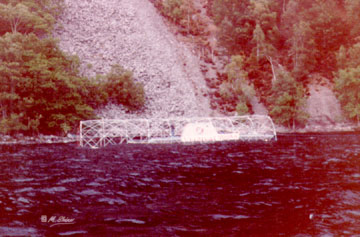
Vladivar "Splash-down
"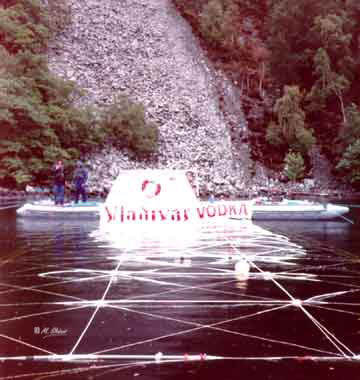
A
sonar transducer monitored the interior of
the trap and in the unlikely event of a capture,
these lines, together with the downhaul would
be released by the raft's crew. The trap could
then rise gently to the surface with the doors
dropping closed at the same time. The raft was
kept attended in the interests of safety all
round and the system worked well on tests.
Finally, on October 2nd it was deemed that the trap had fulfilled
its mission and the bait fish were removed.
On this occasion, all parties seem to have
emerged unscathed.
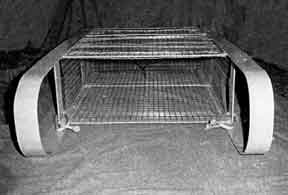
The potential damage to sediments
can be clearly seen. L.N.I. Dredge Early 1970'sCopyright D.
Raynor
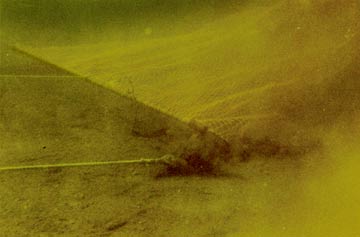
Dredging Trials at Loch Ness
The
above examples, may help to show just how
easy it is to cause damage, however inadvertently
and just how much thought should go into avoiding
it. Even the quest for dead monsters has its
dangers. The LNI did some dredging and trawling
in 1969 and the early 70's.
When another "hunt
for Nessie's bones" proposed dredging in the
mid nineties, the Loch Ness Project made representations
to Scottish Natural Heritage regarding the
protection of the special stratigraphic resource
on the loch's deep basin floors.
This issue
together with those introduced above, is to
be addressed by the proposed code of practice.
In
the meantime, it will help those proposing
to work on Loch Ness to bear in mind the following:
1. British Waterways have a right of unobstructed navigation throughout the length of Loch
Ness since it forms a part of the Caledonian
Canal.
http://www.british-waterways.org/
2. Activities which
might result in the pollution of the loch
are the remit of SEPA (Scottish Environmental
Protection Agency)
ttp://www.sepa.org.uk/
3. The Ness District
Salmon Fishery Board is a statutory body
protecting angling interests and aquatic habitats.
The Board would be concerned with matters
which might be damaging to the native fish
population, particularly the migratory salmon
and sea-trout. The netting of fish in Loch
Ness is prohibited, as is the introduction
of alien fish, as bait for example. Even native
species, may harbour disease. Escaping fish
of farmed origin can also have adverse genetic
effects when breeding with the native fish.
The Clerk, Ness
District Salmon Fishery Board, York House,
20 Church St.,
Inverness
IV1 1ED
4. The SSPCA (Scottish Society for the Prevention of
Cruelty to Animals) would have concerns
over the risks and treatment of individual
animals. Traps, for example could pose a risk
for air breathing mammals such as seals and otters.
Scottish Society for the Prevention of Cruelty to Animals (SSPCA), Braehead
Mains .603 Queensferry Road ,Edinburgh .EH4
6EA
.
Tel:
0131 339 0222
5. SNH (Scottish
Natural Heritage) are responsible for the general protection of habitats within the environment
and would be concerned if there was a possibility
of introducing alien species, for example
as eggs or spores, on equipment which had
been previously used in waters elsewhere.
They, along with the Loch Ness Project, have also expressed concern for the preservation
of the deepwater sediments.
http://www.snh.org.uk/
The Loch Ness & Morar Project have records of most previous activities at Loch Ness and are engaged
in a number of current programmes. We may
be able to assist with information, advice
or refer enquiries to others.
http://www.loch-ness-scotland.com/ and email
to project@loch-ness-project.co.uk
Back to Loch Ness Reflections
|
|




